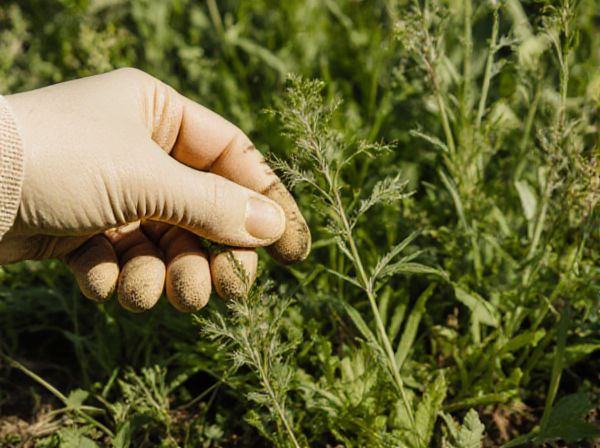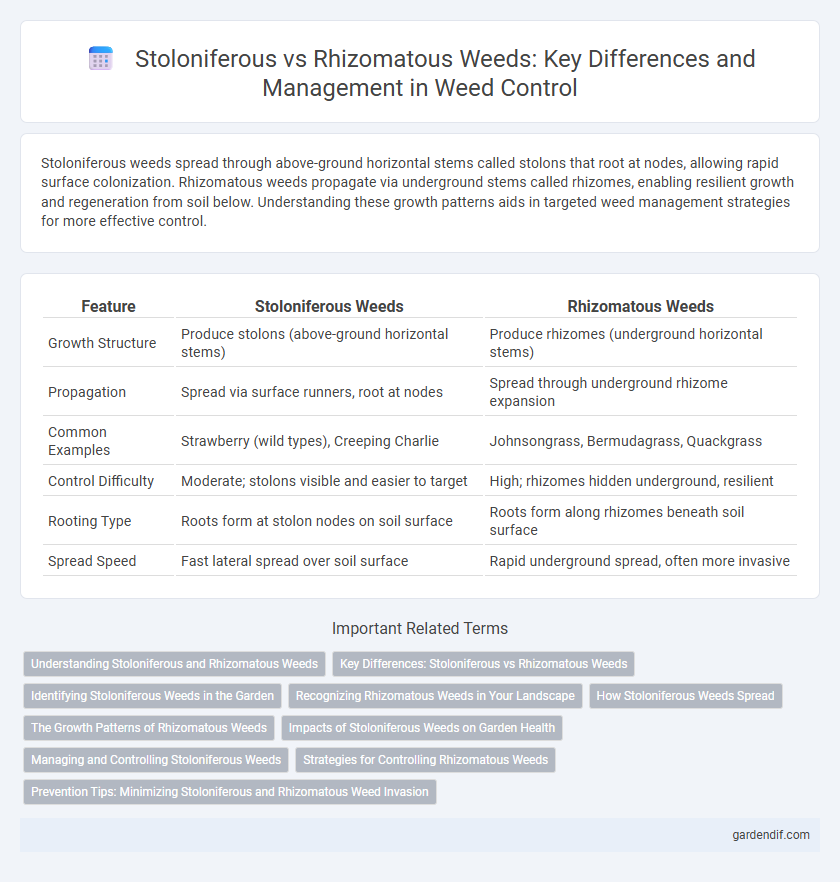
Stoloniferous weeds vs rhizomatous weeds Illustration
Stoloniferous weeds spread through above-ground horizontal stems called stolons that root at nodes, allowing rapid surface colonization. Rhizomatous weeds propagate via underground stems called rhizomes, enabling resilient growth and regeneration from soil below. Understanding these growth patterns aids in targeted weed management strategies for more effective control.
Table of Comparison
| Feature | Stoloniferous Weeds | Rhizomatous Weeds |
|---|---|---|
| Growth Structure | Produce stolons (above-ground horizontal stems) | Produce rhizomes (underground horizontal stems) |
| Propagation | Spread via surface runners, root at nodes | Spread through underground rhizome expansion |
| Common Examples | Strawberry (wild types), Creeping Charlie | Johnsongrass, Bermudagrass, Quackgrass |
| Control Difficulty | Moderate; stolons visible and easier to target | High; rhizomes hidden underground, resilient |
| Rooting Type | Roots form at stolon nodes on soil surface | Roots form along rhizomes beneath soil surface |
| Spread Speed | Fast lateral spread over soil surface | Rapid underground spread, often more invasive |
Understanding Stoloniferous and Rhizomatous Weeds
Stoloniferous weeds spread through above-ground horizontal stems called stolons that root at nodes, enabling rapid colonization of new areas. Rhizomatous weeds propagate via underground stems known as rhizomes, which store nutrients and facilitate survival during adverse conditions. Effective weed management requires identifying these growth habits to target control strategies, as stoloniferous weeds are more susceptible to surface treatments while rhizomatous weeds demand deeper soil interventions.
Key Differences: Stoloniferous vs Rhizomatous Weeds
Stoloniferous weeds propagate through above-ground horizontal stems called stolons, enabling rapid surface spread and colonization, while rhizomatous weeds utilize underground horizontal stems known as rhizomes, allowing them to survive adverse conditions and regrow from subterranean structures. Stoloniferous weeds typically produce roots at nodes along the stolon, facilitating new plant development, whereas rhizomatous weeds develop new shoots and roots from rhizome buds beneath the soil, enhancing persistence and difficulty of eradication. Management strategies must consider these growth patterns, as stoloniferous weeds often respond to surface-targeted treatments, while rhizomatous weeds require deeper soil interventions to disrupt their underground rhizomes.
Identifying Stoloniferous Weeds in the Garden
Stoloniferous weeds spread through above-ground horizontal stems called stolons that root at nodes, creating new plants and quickly colonizing garden areas. Common examples include Bermuda grass and creeping Charlie, which form dense mats that choke out desirable plants. Identifying these weeds involves spotting trailing stems with roots at intervals, helping gardeners target and manage infestations before they dominate the landscape.
Recognizing Rhizomatous Weeds in Your Landscape
Rhizomatous weeds spread underground through horizontal stems called rhizomes, allowing them to rapidly colonize garden beds and lawns, making their recognition crucial for effective management. Unlike stoloniferous weeds that grow above ground with runners, rhizomatous weeds often have thick, fleshy underground stems that store nutrients and enable regrowth after removal. Identifying these characteristics helps gardeners target herbicides and physical control methods to prevent persistent infestations and maintain landscape health.
How Stoloniferous Weeds Spread
Stoloniferous weeds spread primarily through above-ground horizontal stems called stolons that root at nodes to form new plants, enabling rapid colonization across soil surfaces. These spreading stems allow stoloniferous weeds to efficiently cover and invade large areas, making them challenging to control in agricultural and turf environments. Examples include Bermuda grass and creeping bentgrass, both notorious for their aggressive stolon growth.
The Growth Patterns of Rhizomatous Weeds
Rhizomatous weeds grow through underground stems called rhizomes that spread horizontally, allowing rapid colonization and outcompeting other plants. These rhizomes store nutrients and produce new shoots at nodes, enhancing the weed's ability to survive adverse conditions and regenerate after physical damage. Common rhizomatous weeds include Bermuda grass and Johnson grass, which pose significant challenges in agricultural and turf management due to their aggressive growth patterns.
Impacts of Stoloniferous Weeds on Garden Health
Stoloniferous weeds spread rapidly by above-ground runners called stolons, which enable quick colonization of garden soil and surface areas. Their aggressive growth can outcompete desirable plants for nutrients, water, and light, leading to reduced garden biodiversity and plant vigor. The dense mats formed by stoloniferous weeds also hinder air circulation and soil aeration, promoting fungal diseases and negatively impacting overall garden health.
Managing and Controlling Stoloniferous Weeds
Managing stoloniferous weeds requires targeted strategies that disrupt their above-ground runners, such as regular mowing and careful herbicide application to prevent spread. Effective control involves monitoring new stolon growth and removing plants before they root to limit horizontal expansion. Integrating cultural practices like maintaining dense turf and timely irrigation also reduces stoloniferous weed establishment and persistence.
Strategies for Controlling Rhizomatous Weeds
Rhizomatous weeds spread aggressively through underground stems called rhizomes, making them difficult to eradicate. Effective control strategies include deep tillage to disrupt rhizome growth, the use of systemic herbicides that translocate within the plant, and maintaining competitive crop cover to reduce weed establishment. Monitoring and timely intervention are crucial to prevent rhizome regeneration and minimize weed proliferation.
Prevention Tips: Minimizing Stoloniferous and Rhizomatous Weed Invasion
Effective prevention of stoloniferous and rhizomatous weed invasion involves maintaining dense, healthy turfgrass to outcompete these aggressive spreaders. Regular mowing, proper fertilization, and consistent irrigation reduce the open spaces and stress that facilitate their establishment. Incorporating organic mulch and timely application of pre-emergent herbicides further limits the spread of weeds like Bermuda grass and Johnson grass by restricting their horizontal growth through stolons and rhizomes.
Stoloniferous weeds vs rhizomatous weeds Infographic

 gardendif.com
gardendif.com